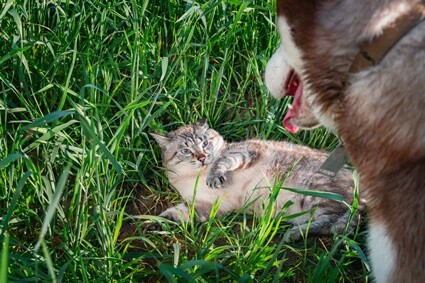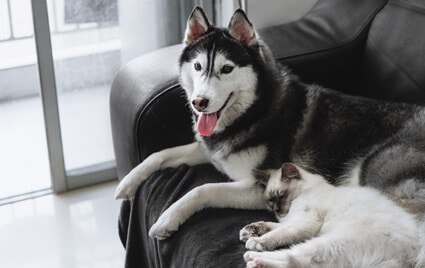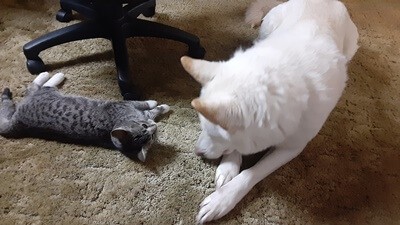We often see videos of cats and dogs cuddled up together on the couch. It makes you wonder if cats and huskies are compatible or what’s required to make the relationship between these two much-loved pets work.
Huskies have a strong prey drive, so they’re likely to chase and behave aggressively toward cats. Consequently, keeping cats and huskies together in a multi-pet household can be challenging. Of course, each husky has a different personality, and training can mean that the introduction of cats and huskies can be made easier.
If you want to keep a cat and a husky in the same home, you’ll need to introduce them slowly and supervise them. However, if you don’t want to take any risks, choose a dog breed that’s more compatible with cats.
Is It Safe for Huskies To Live with Cats?
Some owners have made this combination work, especially in cases where their cats have been sociable and confident.
Also, because huskies tend to be sociable and intelligent, having a cat companion may alleviate loneliness and boredom. Even the Blue Cross agrees that some husky dogs can live with cats.
But, if you’re thinking of keeping cats and huskies together, don’t do it on a whim. It takes planning and preparation to make this relationship work.
Keeping Huskies and Cats Together
Before introducing them, consider the following factors:
- Personality – Companion animals have different temperaments. For example, shy cats will struggle to adjust to a dog, especially a large breed like a husky. Also, some rescue huskies will be intolerant toward cats.
- Age – Raising a husky puppy with cats will be easier than introducing an adult husky to cats.
- How you introduce them – It’s preferable to have a cat first and then introduce a dog. The dog will be entering the cat’s territory, so the cat will feel more able to defend itself.
- Home environment – Both animals will need their own space. Also, your cat will need an escape route from any shared parts of the home.
- Supervision – Huskies should never be left unsupervised with a cat.
Husky Breed: Characteristics And Personality
Siberian huskies with wolf-like features are endearing. In particular, their tendency to sing, howl, and chatter throughout the day.
Although beautiful, these dogs can be a handful. That’s why it’s important to fully understand the husky’s characteristics and personality before getting one.
Key characteristics include:
- An active lifestyle – Working huskies pull sleds for hours at a time. As pets, they require 2 hours+ of exercise per day.
- Talkative – They will howl, sing, and chatter.
- Double-coat – Huskies have a double coat to withstand cold temperatures, so they need to be groomed once a week.
- Big and strong – Huskies are classified as a medium-sized breed, but they grow into powerful dogs.
- Wolf-like facial features – Pricked-up ears and inquisitive eyes.
- 12+ Years – According to AKC, a Siberian husky’s average life expectancy is 12-14 years.
- Minimal odor – This is true of all Sled breeds.
Huskies have exploded in popularity, which has led many people to wonder if a cat can live with a husky.
What Type of Cat will Get Along with a Husky?
Some cats like dogs, especially those brought up around dogs as kittens. Also, cats that are confident and able to defend their territory should be OK around most dogs, as long as they’re introduced properly and supervised.
Siamese and Abyssinian breeds of cats are known for being sociable, confident, and adaptable. They may be more accommodating toward dogs. Also, a semi-feral mixed breed would be able to stand its ground around most canines.
If your cat is declawed, it shouldn’t be forced to live with a dog, as this will leave it feeling vulnerable. If your cat is timid and flighty, it won’t be a good fit for huskies because they have a strong chase drive.
If a cat doesn’t take well to living with a husky, it may move out or become ill due to stress. So, you must consider carefully whether a husky will be a good companion for a cat.
Do Huskies Like Cats?
According to the RSPCA, husky dogs have very individual personalities. So, it’s difficult to predict whether a certain husky will love your cat, chase your cat, or ignore your cat completely.
In most cases, huskies will show an interest in cats. This could be an ‘I-want-to-play-with-you’ kind of interest or an ‘I-want-to-eat-you’ kind of interest. Unfortunately, it’s difficult to tell what’s happening in a husky’s head.
Also, a husky’s attitude toward cats can change over time. There have been cases of husky dogs who’ve been friendly toward a cat for many years but have ended up killing it accidentally or on purpose.
It’s easier to shape behavior when an animal’s young. So, if you want to train a husky to like cats, you should expose it to cats as a puppy.

How To Introduce a Husky Puppy To A Cat
Introducing a husky puppy to a cat is much easier than introducing a 50 lb.-adult husky to a cat.
We’ll show you how to introduce a husky puppy to your cat:
Swap Bedding
For the first few days, keep the puppy and cat in separate rooms.
During this time, take some bedding from your cat’s and dog’s beds and swap them over. This will enable them to adjust to each other’s scents.
Introduction
It’s time to start introducing your puppy to your cat but only do so after your puppy has had its vaccinations.
Ensure your cat is relaxed and the part of the house used for the introduction feels comfortable. Ideally, your cat should be positioned on a raised surface, like a countertop or cat tree, so that it can see the puppy clearly and feel in control of the situation. Also, ensure that there’s a clear escape route for your cat.
Bring your puppy in on a long leash, but don’t go straight up to your cat. Instead, wait and watch to see how their behavior unfolds.
Signs of Severe Anxiety
In all likelihood, your cat will become scared and anxious. However, if your cat becomes extremely distressed, it’ll be kinder to end the interaction and try again later or the next day.
How can you know if your cat is a little stressed or severely distressed? The following would be cause for concern:
- Repetitive screeching and screaming.
- A raised back that doesn’t settle after several minutes.
- Frantically running around the house but not finding somewhere to hide or settle.
If you see these signs, terminate the interaction and ensure your cat is safely separated from your puppy. Also, if your cat starts grooming excessively or stops eating and drinking, it is a sign that the cat is distressed.
Signs of Aggression
During the initial introductions, you should check for aggression in your husky pup and intervene.
Warning signs include:
- Driving the muzzle into the cat
- Erect tail and piloerection of the fur
- Rigid posture
- Lunging toward the cat and pretending to bite
- Licking the cat’s face. This isn’t necessarily a sign of aggression, but could become a dangerous situation
If your pup displays any of the above behaviors, take it to another room. You can try re-introducing it later but only on the lead.
If signs of aggression don’t diminish during interaction sessions, you can try the distraction training method. However, some huskies will always remain aggressive toward cats, regardless of how much training they’re given.
Short and Regular Interactions
In the beginning, keep the interactions short. This will stop your cat from becoming overly stressed and prevent your puppy from becoming overly excited.
If your pets start to become more relaxed in each other’s company, you can then allow them to spend more time together.
Removing the Leash
If safe to do so, let your puppy freely interact with your cat. However, you should only consider removing the leash if you’re confident that your husky pup isn’t aggressive toward your cat.
Escape Routes And Personal Space
If you’re puppy’s interacting with a cat when off the leash, the cat must have a safe place to escape to. So, make sure that any exit routes are not blocked. Never shut a cat and dog in a room together, as this could end badly.
Provide your cat with at least one room that it can call its own. To do this, fix a baby gate on one room and remove one of the bars (or raise the entire gate slightly) so that your cat can get through, but your dog can’t.
Supervise Interactions
Supervise all interactions until you can confidently predict your dog’s behavior. Even then, it’s still a good idea to supervise all interactions. This is the only way to guarantee your cat’s safety because, as mentioned, dogs are never 100% predictable.
Also, you may need to protect your neighbors’ cats. Huskies may learn to love their companion cat but chase after other cats in the neighborhood. So, if your dog uses the yard, you must install a fence that will be high enough to discourage cats from entering your yard.
How to Introduce An Adult Husky To A Cat
Introducing an adult husky to a cat is usually much harder than introducing a husky puppy to a cat. Even if the adult was brought up around other cats, it could be difficult to predict its behavior.
Nevertheless, some owners who have rescued adult huskies have integrated them safely into a household with cats.
This can be achieved with the ‘distraction method.’ This is considered more effective for training adult huskies to behave safely around cats, and it works by encouraging the dog to ignore the cat.
Here’s how it works:
- When you bring your husky into the room, encourage it to focus all its attention on you. You could play its favorite game, for example.
- If your husky focuses its attention on you and largely ignores the cat, reward it. The dog will learn that ignoring the cat wins it more rewards.
If your adult husky approaches your cat but is gentle in its approach, it may not be necessary to continue with the distraction method. However, if there are any signs of aggression, you should continue.
If, after several attempts, your cat and dog don’t get along, it may be helpful to speak to an animal behaviorist. If that doesn’t work, having one of your pets adopted may be the kindest option.

Can You Introduce a Cat to a Resident Husky?
It’s harder to introduce a cat to a household that already has a husky. The cat will feel uncomfortable and will struggle to establish its territory.
It may be possible to introduce kittens to a household with husky dogs, but this would take a lot of care. Supervising the cat/dog and giving the cat at least one room will be necessary.
If your husky has attacked your cat, it goes without saying that you should seek veterinary care, even if there are no visible wounds. Also, this likely means that your cat and dog cannot live safely together.
How To Get Your Husky And Cat To Get Along
Huskies that are bored and under-stimulated are more likely to chase after cats. So, make sure your husky gets enough exercise during the day to feel tired. It’s a good idea to run or cycle with huskies to fulfill their desire to run and chase.
Huskies are sociable animals that require interaction, ideally with other dogs. Ironically, having two husky dogs rather than one will probably reduce the likelihood of attacks on cats. The dogs will be happier and more fulfilled if kept in pairs, so they are less likely to be aggressive.
Feeding your husky quality food may balance its mood and reduce its desire to chase after cats.
Dogs Similar To Huskies That Are Compatible with Cats
Huskies are gorgeous, and they have wonderful personalities. So, it’s no surprise they are popular pets. However, as mentioned, they are not very compatible with cats.
If you are drawn toward the husky breed but are concerned about their instinct to chase, why not consider one of these similar, more cat-friendly breeds instead?
- Hungarian Vizsla – Like huskies, these dogs are devoted to their owners, love the outdoors, and need plenty of exercise. Vizslas show an interest in small animals, but don’t have the same chase-drive as huskies.
- Border Collies – Border collies are just as active as huskies. They have a herding instinct, so they might try to herd a cat, but they are significantly less likely to follow-through and attack a cat.
- Pomeranians –These are small dogs that usually get on well with cats.
- American Eskimo Dogs – These dogs look similar to huskies, but their prey drive is not nearly as strong.
All breeds of dogs can be dangerous to cats. That’s why it’s important to take the dog’s personality into account.

